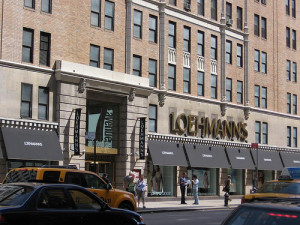February 26, 2014 by Alison Lowenstein
Losing Loehmann’s

http://www.flickr.com/docjohnboy
It feels like everyone has a Loehmann’s story–or at least they did.
Like a hunter who proudly displays a deer head on the living room wall, offering painstaking details of the kill, many women with a Loehmann’s purchase have a novella-length story behind the find. By the end of February, 39 Loehmann’s retail clothing locations will have closed for good, seven years before the discount emporium would have turned 100. Loehmann’s, like the grand resorts and bungalow colonies of the Catskills, will become a legend in American Jewish history.
Losing Loehmann’s is like losing a well-dressed aunt. There were parts of her that exposed your deepest insecurities, especially when she forced you to undress in a room full of strangers. But the love you had for this relative made you feel at home every time you walked through the door.
The store, founded by the late Frieda Loehmann, started in Brooklyn and attracted many fans. Harriet Mandel, a very well-dressed lifelong Loehmann’s shopper, recalled going to Loehmann’s to find a metziya—a bargain, “I grew up in the Loehmann’s culture, way back to the old auto salesroom on Nostrand Ave., with sheets strung for dressing rooms, Back Room dresses for $9.99, and salespeople ‘on the lookout’ for that special item.” Mandel noted that in the early days of Loehmann’s it served a need for many immigrant European Jews, “As if Loehmann’s was waiting for these elegant women from European cities who came penniless. It was an opportunity that allowed them to dress in their tastes at prices they could afford.”
Although we have nostalgic stories of Loehmann’s throughout the decades, Loehmann’s also had the ability unleash the beast within all of us. There were numerous shopping trips where I secretly wished my sister wouldn’t fit into a skirt because I wanted it. Years ago, I was so immersed in the hunt for a dress I didn’t notice my toddler son had left his stroller. Embarrassed to say, in the same breath I alerted the saleswoman my kid was gone, I also instructed her not to put the dresses I had chosen back on the rack. I shouldn’t have been thinking about bargain hunting while searching for my missing son, later found giggling under a rack of shirts–but such was the power of Loehmann’s.
T.V. sitcom “The Nanny” compared the first few minutes of a Loehmann’s sale to the running of the bulls, and the character Fran Fine warns her charge, Gracie, at a Loehmann’s Red Star clearance sale, “You are going to see things today that will haunt you for the rest of your shopping life.” Even the (non-Jewish) humorist Erma Bombeck, titled a book All I Know About Animal Behavior I Learned in the Loehmann’s Dressing Room.
Yet when Loehmann’s announced late in 2013 that it was closing, customers tried to pay their last respects. Barbara Schwartz visited her New Hyde Park location to say goodbye to a favorite fitting room attendant, Doris, but found she wasn’t there any longer. “She stood on her feet for probably close to 50 years. She organized, hung up, and carefully loved all of her merchandise. Doris spent her life in the confines of a public open dressing room taking pure delight when she saw you looking great in a garment. I could sense her smile of satisfaction. Then, I would ask her opinion. She knew just when to encourage the purchase and why.” Schwartz also remarked, “There are stores over the years that imitate Loehmann’s, but there will never be another one. That will bring me to tears. I am both naked and crying.”
During the past decade, there were multiple news stories about Loehmann’s declaring bankruptcy. As well as subtle changes in the store. For instance, I found it suspicious every time I went to the register, the cashier always tried to sell me magazine subscriptions. Astute New Jersey shopper Helen Levine, who spent decades shopping at Loehmann’s Paramus, N.J., store noted, “When they stopped offering the extra discount on my birthday I should have seen the writing on the wall!”
The store played a role in shaping our female identity. It was in the Loehmann’s fitting room that I caught a glimpse of what I’d look like when I was post-menopausal, while I tried not to stare at women with spider veins trying on cocktail dresses. And every time we went to Loehmann’s, my mother joked that the seats outside the fitting room were made for Jewish husbands. As a child, I didn’t dream of marrying a prince; I wanted to marry the kind of guy who’d sit on the bench outside a Loehmann’s fitting room waiting for me. This image encompassed all one would want from a life partner–patience, honesty, and the mutual appreciation for a good deal.
The loss isn’t easy. Loehmann’s was a staple in American Jewish life. From the original Brooklyn location to the pilgrimage most New Yorkers made to the Bronx, you could track the Jewish neighborhoods in America by the Loehmann’s locations.
It will take time before I’m able to remove my gold Loehmann’s Insider Club card from my wallet. And where will we get our dresses for my daughter’s bat mitzvah? I’m mournful for all the years of shopping that have been taken from us. I don’t think we’ll have the same experience nestled up on the couch perusing Gilt and Zappos websites. Like Jewish delis, and the seltzer man, Loehmann’s is another part of American Jewish culture that will now live only in stories. Younger women will feel about these tales of Loehmann’s shopping experiences the way I felt when I heard my older relatives retelling jokes from Borscht Belt comedians. Even as a child, I knew I’d never really get them.
 Please wait...
Please wait...